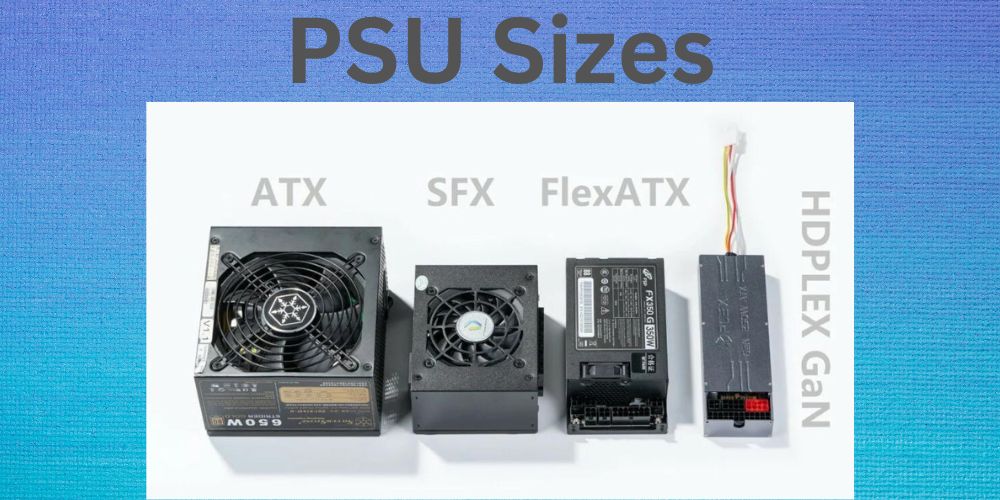Are All PSUs the Same Size?
When building or upgrading a computer, the power supply unit (PSU) is crucial, providing the necessary electrical power for all other components. However, are all PSUs the same size? In this guide, we delve into PSU sizes, their variations, and essential compatibility factors. Understanding PSU dimensions ensures proper fit and functionality within your system. Whether it’s ATX, SFX, or other form factors, knowing the right size for your build is vital. Explore the diverse world of PSU sizes to make informed decisions and optimize your computer’s performance.
Understanding PSU Sizes
Understanding PSU sizes is essential before delving into specifics. PSU size pertains to the physical dimensions, varying among models and manufacturers. This dimension is critical as it dictates fit within your computer case and sufficient power provision for components. Whether a PSU fits and delivers ample power hinges on its size, impacting overall system functionality. Thus, grasping the nuances of PSU sizes ensures optimal compatibility and performance, facilitating informed decisions when selecting and installing a power supply unit for your computer system.
Different PSU Sizes
Regarding Power Supply Units (PSUs), size can vary significantly depending on factors like form factor and wattage. While many PSUs adhere to standard sizes like ATX, there are variations such as SFX, TFX, and more, each with its own dimensions. Additionally, wattage requirements can influence the size, with higher-wattage PSUs often being larger to accommodate additional components and cooling mechanisms. While there are common sizes, verifying compatibility with your PC case and components is essential to ensure a proper fit and adequate power delivery. Thus, while PSUs may share similarities, they’re not universally the same size.
1. ATX PSU
The most common PSU size you’ll encounter is the ATX (Advanced Technology Extended) PSU. An ATX PSU, a standard in desktop computing, provides power to PC components. Measuring around 150mm in width, 86mm in height, and 140mm in depth, it fits most ATX-compatible cases. It offers a range of wattages, from basic to high-performance variants, and accommodates diverse system needs. With standardized connectors and mounting points, it ensures compatibility across builds. ATX PSUs are widely available, making them a reliable choice for powering modern desktop computers with efficiency and reliability.
2. Micro ATX PSU
A Micro ATX PSU is designed for smaller form factor cases, catering to Micro ATX and Mini-ITX builds. Compact in size, it typically measures around 125mm in width, 65mm in height, and 100mm in depth. Despite its smaller footprint, it delivers sufficient power for moderate computing needs. With specialized connectors and mounting options, it ensures compatibility with smaller cases while offering reliable power delivery. Micro ATX PSUs are ideal for compact and space-saving desktop configurations without compromising performance.
3. SFX PSU
An SFX PSU, designed for compact systems, offers high power efficiency in a small form factor. With dimensions typically around 100mm in width, 63mm in height, and 125mm in depth, it fits snugly into SFF cases. Despite its size, it delivers robust power output, suitable for gaming and workstation setups. SFX PSUs feature specialized connectors and mounting options to ensure compatibility with smaller cases, making them an ideal choice for building powerful yet space-efficient systems.
4. TFX PSU
TFX (Thin Form Factor) PSUs are often used in slim and low-profile cases, offering space-saving power solutions. It boasts dimensions typically around 85mm in width, 65mm in height, and 175mm in depth. Despite its small size, it delivers reliable power output, suitable for basic computing needs. TFX PSUs feature specialized connectors and mounting options to fit snugly into slim cases, making them ideal for small form factor builds where space is limited but power efficiency remains paramount.
5. Custom Sizes
In addition to the standard sizes mentioned above, some manufacturers produce custom-sized PSUs for specific cases. Custom-size PSUs are tailored for unique system configurations, offering flexibility in dimensions to fit specific cases and requirements. These PSUs are often designed on-demand or by speciality manufacturers, ensuring compatibility and optimal power delivery for non-standard builds, such as small form factor PCs or custom chassis designs.
Compatibility Factors
Now, let’s address the primary question: Are all PSUs the same size? The answer is no; PSUs come in various sizes, and their compatibility with your system depends on several factors:
1. Case Compatibility: The first and most crucial consideration is whether your computer case can accommodate the size of the PSU you want to use. Most cases are designed to fit standard ATX PSUs, but smaller cases may require SFX or SFX-L PSUs.
2. Mounting Orientation: Some PSUs are designed to be mounted in different orientations, such as top-mounted or bottom-mounted. Ensure your case supports the orientation of your chosen PSU.
3. Wattage Requirements: The size of your PSU can also affect its wattage output. Smaller PSUs may provide less power than their larger counterparts. Make sure the PSU you choose can meet the power demands of your components.
PSU Form Factors and Cases
PSU form factors play a crucial role in case compatibility. ATX PSUs fit standard cases, while smaller form factors like SFX, TFX, and Micro ATX cater to compact builds. Choosing the right PSU size ensures it fits properly within the case, avoiding compatibility issues. Different case sizes and layouts may require specific PSU form factors, so understanding these relationships is essential for building a PC that balances performance, space efficiency, and compatibility.
PSU Size and Wattage
PSU size correlates with wattage capacity, impacting compatibility and performance. Higher-wattage PSUs are often larger to accommodate additional components and cooling systems. Choosing the right size PSU ensures it fits within the case and delivers adequate power for system components. Overestimating wattage can lead to inefficiency, while underestimating may cause instability or damage. Understanding the relationship between PSU size and wattage helps optimize system performance while ensuring reliable power delivery for a wide range of computing tasks.
Choosing the Right PSU Size
To choose the right PSU size for your build, follow these steps:
1. Check Your Case: Determine your case’s maximum PSU size. Refer to your case’s manual or specifications.
2. Consider Future Upgrades: If you plan to upgrade your components in the future, choose a PSU with some headroom in terms of wattage to accommodate potential additions.
3. Evaluate Power Requirements: Calculate the total power requirements of your components, including the CPU, GPU, drives, and other peripherals. Choose a PSU with sufficient wattage to cover your needs.
4. Check Compatibility: Ensure that the PSU form factor and connectors are compatible with your motherboard and other components.
PSU Size Myths Debunked
There are a couple of myths surrounding PSU size that need to be debunked:
1. Bigger PSU is Always Better: While a larger PSU can provide more power, it’s not always necessary. Using a vastly oversized PSU can be inefficient and may lead to higher energy bills.
2. Smaller PSUs are Inadequate: Smaller PSUs, such as SFX or SFX-L, are perfectly capable of powering even high-end gaming systems. Don’t underestimate their capabilities based solely on size.
Conclusion
In conclusion, not all PSU sizes are the same. The size of your power supply unit is an important consideration when building or upgrading your computer. It determines whether it will fit in your case, whether it can provide enough power to your components, and whether it’s compatible with your motherboard. When choosing a PSU, carefully assess your case’s compatibility, power requirements, and any future upgrade plans. By selecting the right PSU size, you can ensure a stable and efficient power supply for your computer.
FAQs
1. Can I use an ATX PSU in a Mini-ITX case?
In most cases, an ATX PSU will not fit in a Mini-ITX case due to size constraints. You’ll need to use an SFX or SFX-L PSU designed for compact cases.
2. Are SFX-L PSUs more powerful than SFX PSUs?
SFX-L PSUs are not inherently more powerful than SFX PSUs. Both can offer various wattage options. The key difference is the physical size, with SFX-L PSUs being slightly longer.
3. Should I always choose the highest wattage PSU available?
No, you should choose a PSU with wattage that matches your system’s power requirements. Using a significantly higher wattage PSU than necessary can be inefficient and more expensive.
4. Are there any advantages to using a smaller PSU in a larger case?
Using a smaller PSU in a larger case can create more space for airflow and cable management. However, make sure the smaller PSU provides sufficient power for your components.
5. Can I use a non-standard PSU form factor in a standard case?
It’s generally not recommended to use non-standard PSU form factors in standard cases, as they may not fit or align correctly with the case’s PSU mounting points. Always check compatibility before purchasing a PSU.
Last Updated on 26 April 2024 by Ansa Imran

Ansa Imran, a writer, excels in creating insightful content about technology and gaming. Her articles, known for their clarity and depth, help demystify complex tech topics for a broad audience. Ansa’s work showcases her passion for the latest tech trends and her ability to engage readers with informative, well-researched pieces.







